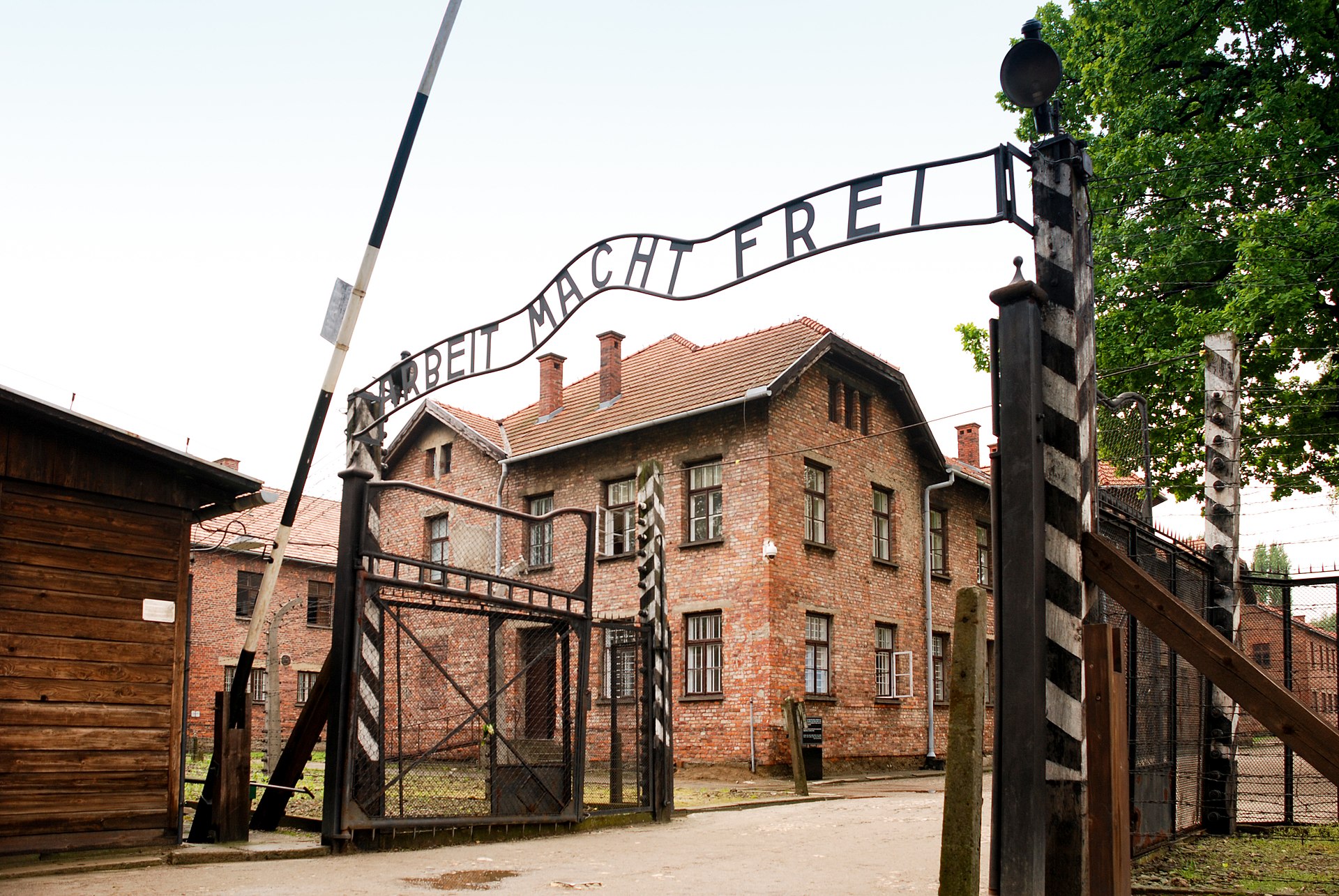
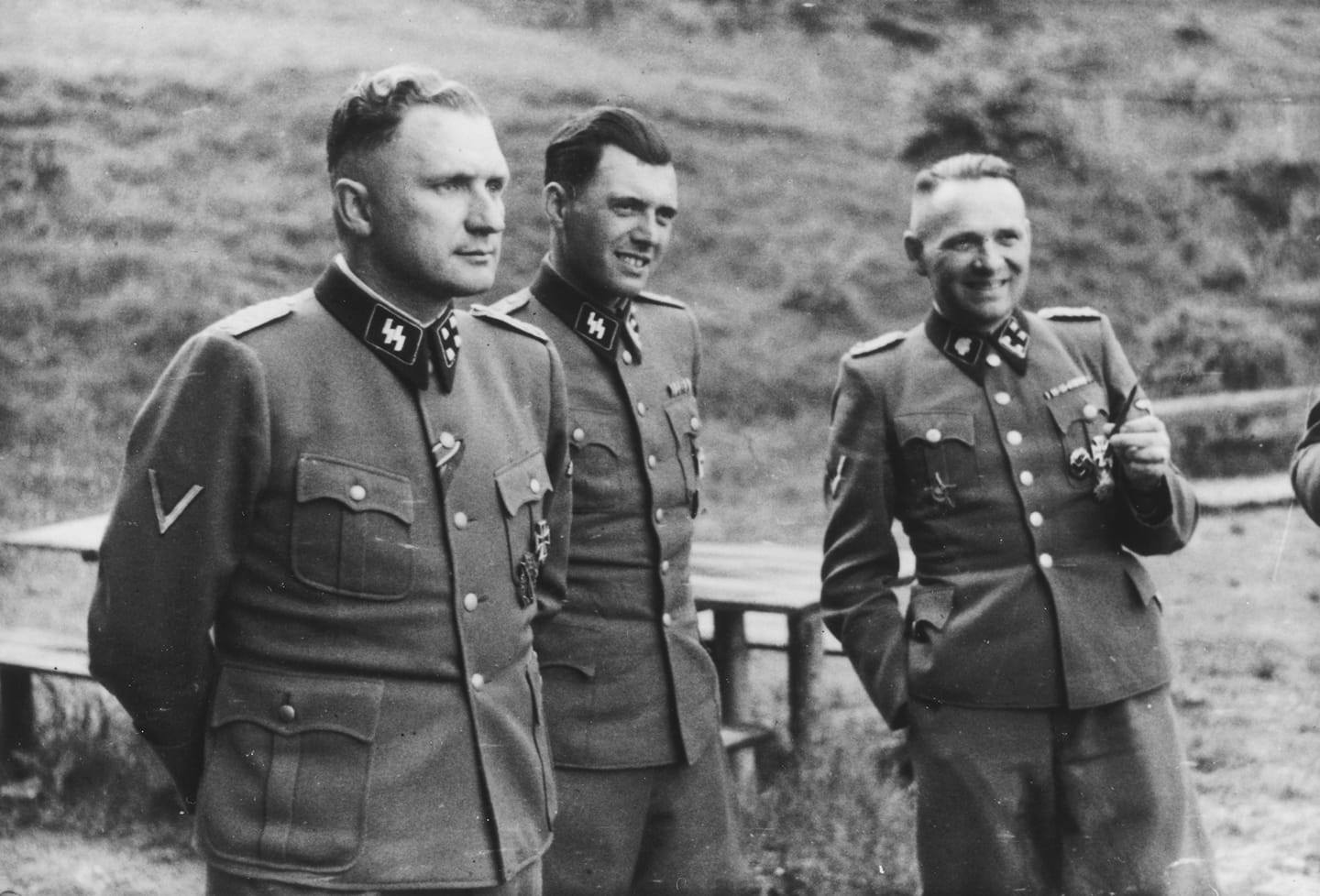
アウシュビッツに医学=医療はあったのか?
Did medicine exisist in
Nazi's Auschwitz?


"Arbeit
macht frei" Das Konzentrationslager Auschwitz-Birkenau /
From
the Höcker Album (left to right): Richard Baer
(Auschwitz commandant from May 1944), Josef Mengele (camp physician),
and Rudolf Höss (first commandant) in Solahütte, an SS resort near
Auschwitz, summer 1944.
ナチ管理下のアウシュビッツ強制収容所に、おびただ しい数のナチの軍医(医者)や看護師が働いていたはずだ。問題は、アウシュビッツに言葉の正しい意味での「医学=医療(medicine)」はあったのかということだ。
ポーランドにかって、Medical Review - Auschwitz (Przegląd Lekarski – Oświęcim)という、ノーベル平和賞の候補にもなった 医学ジャーナルがあったらしい。同サイトからの引用である。
"Medical Review – Auschwitz (Przegląd Lekarski – Oświęcim) was an academic journal of the Kraków Medical Society (Towarzystwo Lekarskie Krakowskie) published in Polish between 1961 and 1991. It investigated the medical, psychological and social consequences of Nazi persecution in concentration camps. Medical Review – Auschwitz is a unique publication worldwide. Spanning over 10,000 pages, or over 1000 articles, the documentation is based on detailed examinations of a few thousands of former concentration camp prisoners. Medical Review – Auschwitz is a collective work of 477 authors, which to this day remains one of the most significant sources of knowledge on the pathology of war and concentration camps./ Medical Review – Auschwitz was started thanks to the efforts of two physicians and former concentration camp prisoners: Antoni Kępiński (1918–1972, prisoner of the concentration camp at Miranda de Ebro in Spain) and Stanisław Kłodziński (1918–1990, prisoner of Auschwitz-Birkenau)./ The journal continued to evolve over the years, expanding in scope and discussing not only the Auschwitz-Birkenau camp – which was the creators’ original intention – but tackling issues present in all German Nazi concentration camps./ The 31 volumes of Medical Review – Auschwitz were nominated for the Nobel Peace Prize in 1993 and 1994./ The editorial board of Medical Review – Auschwitz comprised Professor Józef Bogusz, Jan Masłowski and Professor Zdzisław Jan Ryn, among others."
「Medical Review -
Auschwitz(Przegląd Lekarski -
Oświęcim)は、1961年から1991年にかけてポーランド語で発行されたクラクフ医学協会(Towarzystwo Lekarskie
Krakowskie)の学術雑誌。強制収容所におけるナチスの迫害の医学的、心理学的、社会的影響を調査した。Medical Review -
Auschwitz』は、世界でも類を見ない出版物である。1万ページ以上、1000以上の記事に及ぶこの文書は、数千人の元強制収容所囚人の詳細な検査
に基づいている。Medical Review -
Auschwitzは、477人の著者の共同著作であり、今日に至るまで、戦争と強制収容所の病理学に関する最も重要な知識源の一つとなっている:
アントニ・ケンピンスキ(1918-1972、スペインのミランダ・デ・エブロ強制収容所の囚人)とスタニスワフ・クウォジンスキ(1918-1990、
アウシュヴィッツ・ビルケナウ強制収容所の囚人)である。この雑誌は、創刊者の当初の意図であったアウシュヴィッツ・ビルケナウ強制収容所だけでなく、ド
イツのナチス強制収容所すべてに存在する問題に取り組み、範囲を拡大しながら、長年にわたって進化し続けた。 / Medical Review -
Auschwitz』の編集委員会は、ヨゼフ・ボグシュ教授、ヤン・マスウォフスキ教授、ズジスワフ・ヤン・リン教授らで構成されていた。」
現在、それ[ごく一部]が無料(ポーランド語のオリジナルの他に、英・独・仏・露)でオンラインでみら れるプロジェクト(About the project)がある。以下はそこからの引用である。
"The project has been developed with the aim of sharing all 31 volumes of Medical Review – Auschwitz with the international community by making the articles available free of charge online. Apart from the original volumes of Medical Review – Auschwitz, the website also hosts a selection of articles translated into English, a German anthology Die Auschwitz-Hefte and the 1962 volume in 3 language versions (German, French and Russian)./ At present, additional articles published originally in Medical Review – Auschwitz are being translated from Polish into English, with the goal of making them available online. Ultimately, the website is going to become the source of a wide range of texts from Medical Review – Auschwitz translated from Polish into numerous languages./ A public task co-financed by the Polish Ministry of Foreign Affairs as part of Public Diplomacy 2017 (Dyplomacja Publiczna 2017) competition, Cooperation in Public Diplomacy 2017 (Współpraca w dziedzinie dyplomacji publicznej 2017) component./ The contents of this site reflect the views held by the authors and do not constitute the official position of the Polish Ministry of Foreign Affairs."
「このプロジェクトは、『Medical
Review -
Auschwitz』全31巻の記事をオンラインで無料公開し、国際社会と共有することを目的として開発された。現在、『Medical Review
-
Auschwitz』誌に掲載された記事をポーランド語から英語に翻訳中である。最終的に、このウェブサイトは、ポーランド語から多数の言語に翻訳された
『Medical Review -
Auschwitz』の幅広いテキストの情報源となる予定である。/ポーランド外務省が共同出資する公共課題であり、「パブリック・ディプロマシー
2017(Dyplomacja Publiczna
2017)」コンペティション、「パブリック・ディプロマシーにおける協力2017(Współpraca w dziedzinie
dyplomacji publicznej
2017)」コンポーネントの一部である。/このサイトの内容は、執筆者の見解を反映したものであり、ポーランド外務省の公式見解を示すものではない。」
■非人道的な人体実験や標本収集に関わった関係者(「ニュルンベルク医師裁判」も参照)
| Karl Brandt(1904 - 1948) | 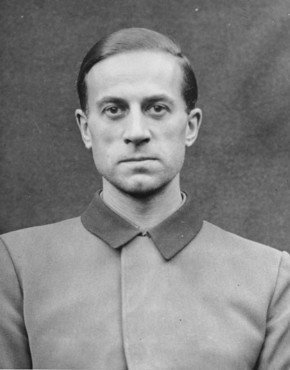 w150px |
Karl Brandt was born
in
Mühlhausen, Alsace (then in Germany). He became a medical doctor in
1928. He joined the NSDAP in January 1932, and became a member of the
SA in 1933. He became a member of the SS in July 1934 and was appointed
Untersturmführer. From the summer of 1934 he was Hitler's personal
physician. He received regular promotions from the SS and, by January
1943, Brandt was a major general. In August 1944, Brandt was appointed Reich Commissioner for Sanitation and Health, ranked as the highest Reich authority. He was authorized to issue instructions to the medical organizations of the government, to the party, and the armed forces, in the field of health. He participated in the euthanasia program beginning in 1939, which involved the systematic execution of the aged, insane, incurably ill, or deformed children by gas or lethal injections in nursing homes, hospitals and asylums. They were regarded as 'useless eaters' and a burden to the German war machine. On April 16, 1945, he was arrested by the Gestapo, and was condemned to death by a court at Berlin. He was released from arrest by order of Karl Doenitz on May 2, 1945. On May 23, 1945, he was placed under arrest by the British. Brandt was one of the 15 defendants found guilty of war crimes at the Doctors Trial. He was executed June 2, 1948 at Landsberg prison in Bavaria. |
カー
ル・ブラントは、アルザス(当時ドイツ)のミュールハウゼンに生まれた。1928年に医学博士となる。1932年1月にNSDAPに入党し、1933年に
SAの一員となる。1934年7月に親衛隊の一員となり、親衛隊上級大将に任命される。1934年夏からヒトラーの専属医となる。親衛隊から定期的に昇進
し、1943年1月には少将になった。 1944年8月、ブラントは帝国衛生・保健総監に任命され、帝国最高権威者として位置づけられた。彼は、政府、党、軍隊の医療組織に対して、保健の分野で の指示を出す権限を与えられていた。 1939年に始まった安楽死計画に参加し、老人ホーム、病院、精神病院、アシルムの中で、老人、精神異常者、不治の病、奇形児をガスや致死注射で組織的に 処刑した。彼らは「役立たずの食いしん坊」であり、ドイツの戦争マシンにとって重荷であるとみなされていた。 1945年4月16日、ゲシュタポに逮捕され、ベルリンの裁判所で死刑宣告を受ける。1945年5月2日、カール・ドゥエニッツの命令により逮捕を解かれ る。1945年5月23日、イギリス軍に逮捕される。 ブラントは、ドクターズ裁判で戦争犯罪を犯したとされた15人の被告のうちの1人であった。1948年6月2日、バイエルン州のランズベルグ刑務所で処刑 された。 |
| Carl Clauberg (1898 - 1957) |
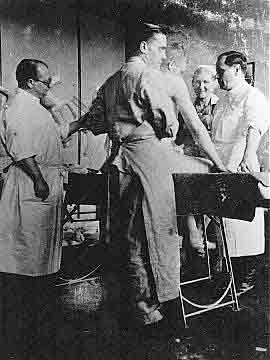 C. Clauberg, left |
Professor Dr. Carl Clauberg was
born in Wuppertal in 1898 into a craftsmen family. He participated in
World War I as infantryman, later studied medicine and avanced to
doctor-in-chief at the University gynaecological clinic in Kiel. He
entered the NSDAP in 1933 and became a fanatical supporter of its
ideology. In the same year, he was appointed professor for gynaecology
at Koenigsberg University. In 1942, he asked Heinrich Himmler, who had already been interested in Claubergs “research,” to offer him the possibility to sterilize a multitude of people for his experiments. Thus, Clauberg came to Auschwitz in December 1942 and part of Block No. 10 in the Main Camp was put at his disposal.. Looking for a “cheap and efficient” method to sterilize women, he injected acid liquids to their uterus without anaesthetics. Thousands of Jewish and Gypsy women were subjected to this treatment. They were sterilized by the injections, producing horrible pain, inflamed ovaries, bursting spasms in the stomach, and bleeding. The injections seriously damaged the ovaries of the victims, which were then removed and sent to Berlin. Clauberg's experiments killed some of his subjects, and others were put to death so that autopsies could be performed. In June 1943, Clauberg wrote to Himmler: "The non-surgical method of sterilizing women that I have invented is now almost perfected . . . As for the questions that you have directed to me, sir, I can today answer them in the way that I had anticipated: if the research that I am carrying out continues to yield the sort of results that it has produced so far (and there is no reason to suppose that this shall not be the case), then I shall be able to report in the foreseeable future that one experienced physician, with an appropriately equipped office and the aid of ten auxiliary personnel, will be able to carry out in the course of a single day the sterilization of hundreds, or even 1,000 women." Clauberg escaped the approaching Red Army and went to Ravensbruck concentration camp, where he continued his experiments. It was estimated that he had sterilized some 700 women. In 1948, he was put to trial in the Soviet Union and sentenced to 25 years; seven years later, he was pardonned and went back to the Federal Republic of Germany. Upon returning he held a press conference and boasted of his scientific work at Auschwitz. After survivor groups protested, Clauberg was arrested in 1955 but died in August 1957, shortly before his trial should have started. |
カー
ル・クラウベルク教授は、1898年、ヴッパータールの職人の家に生まれた。第一次世界大戦に歩兵として参加し、その後医学を学び、キールの大学付属婦人
科診療所の主任医に昇進した。1933年にNSDAPに入党し、そのイデオロギーの狂信的な支持者となる。同年、ケーニヒスベルク大学の婦人科教授に任命
される。 1942年、すでにクラウベルクの「研究」に関心を抱いていたハインリッヒ・ヒムラーに、実験のために多数の人間を不妊化することを依頼する。こうして、 クラウベルクは1942年12月にアウシュビッツにやってきて、収容所第10ブロックの一部を彼の自由に使えるようにしたのである。彼は、女性を不妊化す る「安価で効率的な」方法を探して、麻酔なしで酸性の液体を子宮に注射した。 何千人ものユダヤ人とジプシーの女性がこの治療を受けたのです。注射によって、ひどい痛み、卵巣の炎症、胃の破裂するような痙攣、出血が起こり、不妊手術 が行われたのです。注射によって卵巣はひどく傷つき、摘出されてベルリンに送られた。 クラウバーグの実験によって、被験者の何人かは死亡し、他の人々は検死を行うために死刑にされた。 1943年6月、クラウベルクはヒムラーにこう書いている。 「私が発明した非外科的な女性の不妊手術の方法は、今ではほとんど完成しています。私が行っている研究がこれまでと同じような結果を出し続けるなら(そう ならないと考える理由はない)、近い将来、経験豊かな医師一人が、適切な設備のある診察室と10人の補助要員の助けを借りれば、一日のうちに数百、あるい は千人の女性の避妊手術を行うことができると報告できるようになるだろう" と。 クラウベルクは迫り来る赤軍から逃れ、ラーベンスブルック強制収容所に入り、そこで実験を続けた。そこで彼は実験を続け、約700人の女性を不妊化したと 言われている。1948年、ソ連で裁判にかけられ、懲役25年の判決を受けたが、7年後に恩赦を受けてドイツ連邦共和国に帰国した。帰国後、記者会見を開 き、アウシュビッツでの科学的研究を誇った。 生存者団体が抗議したため、1955年に逮捕されたが、裁判が始まるはずの1957年8月に死亡した。 |
| Aribert Heim
(1914 - 1992) |
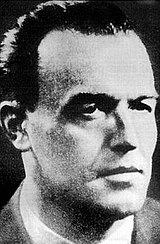 |
Dr. Aribert Heim was a doctor at
the Mauthausen concentration camp during World War II and known to
inmates as "Dr. Death". Heim was known for performing often-fatal
operations and experiments on patients which included injecting various
solutions into Jewish prisoners' hearts to see which killed them the
fastest, operating without anesthesia, and removing organs from healthy
inmates and then leaving them to die on the operating table. Until the
2009 discovery of his death, Heim remained the Simon Wiesenthal
Center's most wanted Nazi war criminal and there was a reward of
$405,000 for information that would lead to his capture. Heim was born on June 28, 1914 in Radkersburg, Austria and joined the local Nazi party in 1935, three years before Austria was annexed by Germany. In 1940, he later volunteered to join Hitler's elite Waffen SS. In October 1941, Heim was assigned to Mauthausen near Linz, Austria as a camp doctor. While at the concentration camp, Heim worked closely with SS pharmacist Erich Wasicky and carried out gruesome experiments likened to those of Joseph Mengele at Auschwitz. Heim was also a doctor at Buchenwald and Sachsenhausen concentration camps. In February 1942, Heim began serving in the 6th SS Mountain Division Nord in Northern Finland where he was an SS doctor in Oulu's hospitals. Heim was captured by US soldiers on March 15, 1945 and sent to a camp for prisoners of war. He was released and avoided immediate prosecution due to the mysterious omission of his time at Mauthausen from his American-held file in Germany. Following his release, Heim worked as a gynecologist in the German spa town Baden-Baden, where he lived with his wife and two sons. Heim disappeared in 1962 when he was warned that a warrant had been issued for his arrest and investigators were waiting for him at his residence. Though there were sightings reported of Heim in Latin America, Europe, and Africa, it was later discovered that he settled in Cairo, Egypt after driving through France, Spain, and Morocco in 1962. In Egypt, Heim converted to Islam at the Al Azhar mosque and lived under the false name Tarek Hussein Farid. Despite being in hiding, Heim continued to correspond with friends and family in Europe and received money from his late sister, Herta Barth. Details of Heim's life in hiding and death were jointly reported by the German public broadcaster ZDF and the New York Times in February 2009. The Baden-Wuerttemberg State Criminal Investigations Office confirmed the news source reports of Heim's death the following day. Investigators acquired a certified copy of a death certificate from Egyptian authorities, along with other documents proving the name change, for Tarek Hussein Farid showing that Heim died in 1992. During a series of interviews with Heim's family, his son Rüdiger admitted that he had been with his father when he died of intestinal cancer on August 10, 1992. Heim's son learned about the Dr. Heim's whereabouts from his late aunt, Herta Barth. Rüdiger also learned from his father that there had been other ex-Nazis in hiding in Egypt. Sources: Ha'aretz; The New York Times; Wikipedia -from Aribert Heim. |
アリベルト・ハイム博士は、第二次世界大戦中のマウトハウゼン強制収容所の
医師で、収容者の間では「死の博士」と呼ばれていた。ハイムは、ユダヤ人囚人の心臓に様々な溶液を注入し、どれが最も早く死ぬかを調べる実験や、麻酔なし
の手術、健康な囚人から臓器を取り出し、手術台で死なせるなど、患者に対してしばしば致命的な手術や実験を行うことで知られていました。2009年に死亡
が判明するまで、ハイムはサイモン・ウィーゼンタール・センターの最重要指名手配中のナチス戦犯であり続け、彼の逮捕につながる情報に対して40万5千ド
ルの報奨金がかけられていた。 ハイムは1914年6月28日にオーストリアのラドカースブルクで生まれ、オーストリアがドイツに併合される3年前の1935年に地元のナチス党に入党し ました。1940年、彼はヒトラーの精鋭部隊であるヴァッフェン親衛隊に志願した。1941年10月、収容所医師としてオーストリア・リンツ近郊のマウト ハウゼンに配属された。収容所ではSS薬剤師のエーリッヒ・ワシッキーと密接に働き、アウシュビッツのヨーゼフ・メンゲレと同じような恐ろしい実験を行っ ていた。ハイムは、ブッヘンヴァルトとザクセンハウゼン強制収容所でも医師を務めました。 1942年2月、ハイムはフィンランド北部の第6SS山岳師団ノルドに従軍し始め、オウルの病院でSS医師として勤務した。 1945年3月15日、アメリカ兵に捕まり、捕虜収容所に送られた。しかし、アメリカ軍が保管していたドイツでのファイルからマウトハウゼンでの記録が削 除されていたため、すぐに釈放され起訴は免れた。釈放後、ハイムはドイツの温泉街バーデン・バーデンで婦人科医として働き、妻と2人の息子と暮らしてい た。1962年、逮捕状が発行され、捜査官が待ち構えていることを知らされ、ハイムは姿を消した。 中南米、ヨーロッパ、アフリカで目撃情報があったが、1962年にフランス、スペイン、モロッコを経て、エジプトのカイロに落ち着いたことがわかった。エ ジプトでは、アル・アズハル・モスクでイスラム教に改宗し、タレク・フセイン・ファリドという偽名で生活していた。潜伏中もハイムはヨーロッパの友人や家 族と連絡を取り合い、亡き姉ヘルタ・バルトから金を受け取っていた。 ハイムの潜伏生活と死の詳細は、2009年2月にドイツ公共放送ZDFとニューヨーク・タイムズが共同で報道した。バーデン=ヴュルテンベルク州刑事局は 翌日、報道機関によるハイムの死に関する報道を確認した。捜査当局は、エジプト当局からタレク・フセイン・ファリドの死亡証明書の認証コピーを入手し、そ の他の改名を証明する文書とともに、ハイムが1992年に死亡したことを示した。ハイムの家族との一連のインタビューで、息子のリュディガーは、父親が 1992年8月10日に腸の癌で死んだとき、一緒にいたことを認めました。ハイムの息子は、亡き叔母のヘルタ・バルトからハイム博士の居場所を聞いたとい う。リュディガーはまた、父親から、エジプトに他の元ナチが潜伏していたことを知った。 |
| August Hirt (1898 - 1945) |
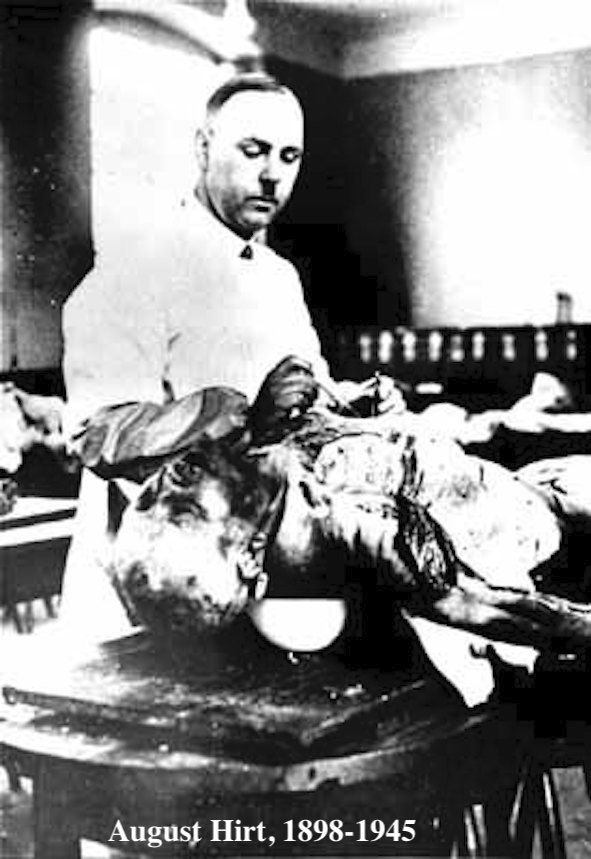 アウグスト・ヒルト |
In 1942, SS-Hauptsturmführer
Prof. Dr. August Hirt, chairman of the anatomy department at the Reich
University in Strassbourg, set about assembling a collection of Jewish
skeletons under the auspices of the Ahnenerbe Foundation. To this end,
he received permission from Himmler to select the required number of
prisoners at Auschwitz. The selection of 115 persons (79 Jewish men, 30
Jewish women, 2 Poles, and 4 "Asians" — probably Soviet POWs) and the
preliminary preparation, consisting of biometrical measurements and the
collection of personal data, were carried out by Hirt's collaborator,
SS-Hauptsturmführer Dr. Bruno Beger,
who arrived in Auschwitz in the
first half of 1943. Berger finished his work by June 15, 1943. After
going through quarantine, some of the prisoners whom Berger selected
were sent in July and early August to Natzweiler-Struthof, where they
were killed in the gas chamber. The victims' corpses were sent to Hirt
as material for his skeleton collection, which was intended for use in
anthropological studies that would demonstrate the superiority of the
Nordic race. Hirt selected thirty-nine women for their racial characteristics: [They] were given a sham physical examination for reassurance, then gassed....the corpses were immediately transported to the anatomy pavilion of the Strasbourg University Hospital. A French imate, who had to assist the project's director...told how "preservation began immediately," with the arrival of bodies that were "still warm, the eyes...wide open and shining." There were two subsequent shipments of men, from each of whom the left testicle had been removed and sent to hirt's anatomy lab. A part of Hirt's skull collection is said to have been moved to the Mittersill castle in the fall of 1944. Hirt was captured at Strasbourg by French troops, who found "many wholly unprocessed corpses,"many "partly processed corpses", and a few that had been "defleshed...late in 1944," and their heads burned to avoid any possibility of identification. Hirt killed himself in Schonenbach, in Neustadt district, on June 2, 1945. Sources: The Auschwitz-Birkenau Museum; Gutman, Israel. ed. Encyclopedia of the Holocaust. Vols. 1-4. NY: Macmillan, 1995; Lifton, Robert J. The Nazi Doctors: Medical Killings and the Psychology of Genocide. NY: Basic Books, 1986. - from, August Hirt. |
1942年、ストラスブールの帝国大学解剖学部長であった親衛隊上級大
将アウグスト・ヒルト博士は、アーネンエルベ(アーネンエアベ)財団の支援のもと、ユダヤ人
の骨格標本の収集に取り掛かった。そのために、彼はヒムラーの許可を得て、アウ
シュビッツの囚人から必要な人数を選び出した。115人(ユダヤ人男性79人、ユダヤ人女性30人、ポーランド人2人、「アジア人」4人-おそらくソ連の
捕虜)の選別と、生体測定と個人情報の収集からなる事前準備は、ヒルトの協力者であるSS親衛隊上級幹部ブルーノ・ベガー博士が1943年の前半にアウ
シュヴィッツに到着して実施された。ベルガーは1943年6月15日までに仕事を終えた。検疫検査を経て、ベルガーが選別した囚人の一部は、7月から8月
初めにかけて、ナッツヴァイラー・シュトルートホーフに送られ、そこでガス室で殺された。犠牲者の死体は、北欧人種の優位性を証明する人類学的研究に使用
するための骨格コレクションの材料として、ヒルトに送られた。 ヒルトは、人種的特徴から39人の女性を選んだ。 [死体はすぐにストラスブール大学病院の解剖学教室に運ばれた。ストラスブール大学病院の解剖室に運ばれた死体は、「まだ温かく、目は大きく見開かれ、輝 いていた」と、このプロジェクトの責任者を補佐していたフランス人のイマートさんが話している。その後、2人の遺体が運ばれてきたが、いずれも左の睾丸が 取り除かれ、ヒルトの解剖学研究室に送られた。 ヒルトの頭蓋骨コレクションの一部は、1944年秋にミッターシル城に移されたと言われている。ストラスブールでフランス軍に捕らえられたヒルトは、「完 全に処理されていない多くの死体」、「部分的に処理された多くの死体」、そして「1944年末に肉を剥離し、識別の可能性を避けるために頭を焼いたいくつ かの死体」を発見した。 ヒルトは1945年6月2日、ノイシュタット地区のショーネンバッハで自殺した。 |
| Johann Paul Kremer (1883 - 1965) |
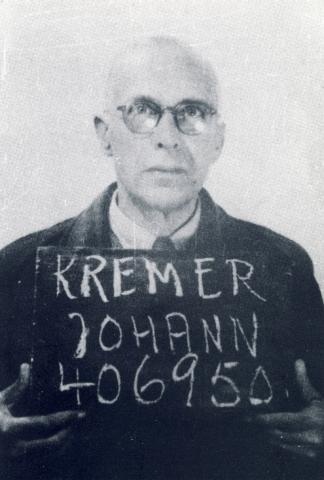 |
SS-Obersturmführer Johann Paul
Kremer, M.D., Ph.D., was an assistant professor at the University of
Münster. As a physician of the Waffen SS, Kremer was ordered to
Auschwitz on August 30, 1942, where he replaced a doctor who had fallen
sick. He carried out his duties there only for a short time — less than
3 months. His job was to assess prisoners attempting to gain admission to the hospital. Kremer ordered most of them killed by phenol injection. He selected prisoners who struck him as particularly good experimental material, and questioned them just before their deaths, as they lay on the autopsy table awaiting injection, about such personal details as their weight before arrest and any medicines they had used recently. In some cases, he ordered these prisoners photographed. He witnessed gassings in Auschwitz and wrote about them in his diary: September 2, 1942 For the first time, at 3:00 A.M. outside, attended a special action. Dante's Inferno seems to me almost a comedy compared to this. They don't call Auschwitz the camp of annihilation for nothing! September 5, 1942 In the morning attended a special action from the women's concentration camp (Muslims); the most dreadful of horrors. Master-Sergeant Thilo (troop doctor) was right when he said to me that this is the anus mundi. In the evening towards 8:00 attended another special action from Holland. Because of the special rations they get a fifth of a liter of schnapps, 5 cigarettes, 100 g salami and bread, the men all clamor to take part in such actions. Today and tomorrow (Sunday) work. After the war, Johann Paul Kremer testified about his diary. An extract is found in The Good Old Days: The Holocaust As Seen by Its Perpetrators and Bystanders, Ernst Klee, Willi Dressen, and Volker Riess, Eds., 1991, p. 258: Particularly unpleasant was the gassing of the emaciated women from the women's camp, who were generally known as 'Muslims'. I remember I once took part in the gassing of one of these groups of women. I cannot say how big the group was. When I got close to the bunker [I saw] them sitting on the ground. They were still clothed. As they were wearing worn-out camp clothing they were not left in the undressing hut but made to undress in the open air. I concluded from the behavior of these women that they had no doubt what fate awaited them, as they begged and pleaded to the SS men to spare them their lives. However, they were herded into the gas chambers and gassed. As an anatomist I have seen a lot of terrible things: I had had a lot of experience with dead bodies, and yet what I saw that day was like nothing I had ever seen before. Still completely shocked by what I had seen I wrote in my diary on 5 September 1942: 'The most dreadful of horrors. Hauptscharführer Thilo was right when he said to me today that this is the anus mundi', the anal orifice of the world. I used this image because I could not imagine anything more disgusting and horrific. SS-Doctor Kremer at a hearing on 18 July 1947 in Cracow Kremer was tried at the Auschwitz Trial in November-December 1947. Through his diary and depositions, the court concluded that Kremer participated 14 times in mass murders (gassings). Kremer said he sat with the driver and, after the completion by SS men of their duties, he drove away. Prosecutors said that witnesses questioned in the trial of the camp Commandant, Rudolf Höss, maintained that the duty of doctors assigned to the gassings was to supervise the poisoning of the prisoners and to decide when the gas chambers were to be opened, and that there was no reason to believe Kremer's duties were different.. According to Kremer's diary, he also was involved on September. 1, 1942, in the shooting of some undefined persons with small caliber arms; on October 17, in 11 executions; on October 19, in the execution of 7 Polish civilians; on October 24, in "stuffing" 6 women who had participated in an uprising. At the Block No. 28 clinic in the main camp, Kremer carried out assessments of prisoners attempting to gain admission to the hospital. Many of them were at the point of exhaustion, in the "Musselman" state, in the final stages of starvation to death. One witness testified that Kremer carried out the "sick block" (hospital) selections of the prisoner in as ruthless a manner as that of the other SS doctors. Kremer did not examine the sick, he assessed them by their appearance. Kremer ordered most of them killed by phenol injection. Kremer selected prisoners who struck him as particularly good experimental material, and questioned them just before their deaths, as they lay on the autopsy table awaiting injection, about such personal details as their weight before arrest and any medicines they had used recently. In some cases, he ordered these prisoners photographed. Before their bodies were cold, they were subjected to autopsies and slides were made for Kremer of the liver, spleen, and pancreas. Kremer said he was interested in the changes that occur in the human body as a result of starvation. He was given permission to collect material that interested him from prisoners put to death by injections of phenol. The prosecution was unable to calculate the exact number of victims for whose death he was responsible, but, in one diary entry Kremer had noted that 1,600 people had been murdered in one day. The prosecutors estimated that given Kremer's involvement in the gassings, he was likely to have been involved in the deaths of several thousand prisoners. Kremer was found guilty of war crimes and sentenced to death. The sentence was later commutted to life imprisonment. Sources: Angels of Death; The Mazal Library; The Auschwitz-Birkenau Museum - Johann Paul Kremer. |
親
衛隊上級大将ヨハン・パウル・クレマー(Johann Paul
Kremer)医学博士、ミュンスター大学助教授。ヴァッフェンSSの医師として、クレーマーは1942年8月30日にアウシュビッツに派遣され、病気に
なった医師の代わりとなった。そこで彼が職務を遂行したのは、わずか3ヶ月足らずの短い期間であった。 彼の仕事は、病院への入院を試みる囚人を評価することでした。クレーメルは、そのほとんどをフェノール注射で殺すように命じた。彼は、特に実験材料になり そうな囚人を選び、死の直前、解剖台に横たわり注射を待っている間に、逮捕前の体重や最近使った薬など、個人的な事柄を質問したのである。場合によって は、これらの囚人の写真撮影を命じたこともあった。 彼は、アウシュビッツでガス処刑を目撃し、そのことを日記に書きました。 1942年9月2日 初めて、午前3時に外で、特別措置に立ち会った。ダンテの地獄篇は、これに比べれば、ほとんど喜劇のように思える。アウシュビッツを "殲滅収容所 "とは呼ばない。 1942年9月5日 朝、女性強制収容所(ムスリム)の特別行動に参加した。最も恐ろしい恐怖である。ティロ軍曹(部隊の医師)が私に、これは世界の肛門だと言ったのは正し かった。夕方8時頃、オランダからの別の特別行動に参加した。彼らは1リットルのシュナップスの5分の1、タバコ5本、100gのサラミとパンをもらえる 特別配給のため、男たちは皆このような行動に参加したくてたまらないのだ。今日と明日(日曜日)は仕事だ」。 戦後、ヨハン・パウル・クレーマーは自分の日記についてこう証言している。その抜粋は『古き良き時代』に掲載されている。The Holocaust As Seen by Its Perpetrators and Bystanders, Ernst Klee, Willi Dressen, and Volker Riess, Eds., 1991, p. 258.にその抜粋が載っている。 特に不快だったのは、一般に「イスラム教徒(ムスルマン)」として知られていた女性収容所のやせ細った女性たちへのガス処刑であった。私は、このような女 性のグループの一つのガス処刑に参加したことがあると記憶しています。その集団がどれくらいの規模だったかは分からない。 私が壕の近くに行くと、彼女たちが地面に座っているのが見えました。彼 女たちはまだ服を着ていました。彼女たちは、着古したキャンプ服を着ていたので、脱衣小屋に残されたのではなく、野外で服を脱がされたのです。 私は、彼女たちの様子から、自分たちにどんな運命が待ち受けているのか疑いもせず、SSの男たちに命だけは助けてほしいと懇願しているのだろうと思いまし た。しかし、彼女たちはガス室に押し込められ、ガス処刑された。 私は解剖学者として、多くの恐ろしいものを見てきた。しかし、その日見たものは、今まで見たこともないようなものだった。私は、見たものに完全にショック を受けながらも、1942年9月5日の日記に「恐怖の中の恐怖」と書きました。ティロ親衛隊長が今日私に言った「これは世界の肛門である」という言葉は正 しかった。 私がこのイメージを使ったのは、これ以上嫌で恐ろしいものはないと思ったからです。 1947年7月18日、クラクフでの聴聞会でのSS医師クレーメル クレーメルは1947年11月から12月にかけてアウシュビッツ裁判で裁かれました。裁判所は、彼の日記と供述によって、クレマーが14回大量殺戮(ガス 処刑)に参加したと結論づけた。クレーメルは、運転手と同席し、SS隊員が職務を終えた後、車を走らせたという。検察は、収容所司令官ルドルフ・ヘスの裁 判で尋問された証人が、ガス処刑に割り当てられた医師の任務は、囚人の毒殺を監督し、ガス室をいつ開けるかを決めることであり、クレーメルの任務がこれと 異なっていたと信じる根拠はないとしている。 クレーメルの日記によると、彼は、1942年9月1日にも関与している。1942年9月1日、小口径武器で不特定多数の人を射殺、10月17日、11名の 処刑、10月19日、7名のポーランド民間人の処刑、10月24日、蜂起に参加した女性6名の「詰め腹」に関与していたのである。 収容所の28番ブロックの診療所で、クレーメルは、病院に入院しようとする囚人達の査定をしました。彼らの多くは、疲弊の極みにあり、「ミュセルマン」状 態で、餓死寸前の状態でした。ある目撃者は、クレマーが他のSS医師と同様に冷酷な方法で囚人の「病人ブロック」(病院)選別を実行したと証言している。 クレマーは病人を診察せず、その外見で評価した。 クレーメルは、彼らのほとんどをフェノール注射で殺すように命じた。クレマーは、特に実験材料になりそうな囚人を選び、死の直前に解剖台に横たわり注射を 待っている間に、逮捕前の体重や最近使った薬など個人的な事柄を質問したのです。場合によっては、写真撮影を命じたりもした。遺体が冷える前に解剖し、肝 臓、脾臓、膵臓のスライドを作り、クレーメルに見せた。クレーメルは、飢餓による人体の変化に興味があるという。彼は、フェノールを注射して死刑にした囚 人から、彼の興味を引く資料を集める許可を得た。 検察は、彼の責任で死んだ犠牲者の正確な数を計算することはできませんでしたが、クレマーはある日記の中で、1日に1600人が殺されたと書いています。 検察側は、クレーメルがガス処刑に関与したことから、数千人の捕虜の死に関与した可能性が高いと推定した。 クレーメルは戦争犯罪で有罪となり、死刑を宣告された。この判決は、後に無期懲役に減刑された。 |
| Maria Mandel
[also Mandl] (1912 - 1947) |
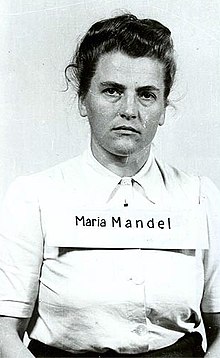 |
The sadistic SS-Oberaufseherin
Maria Mandel was born at Munzkirchen in Austria in January 1912 and
joined the SS in 1938. From October 1938 to May 1939 she was Aufseherin
at KZ Lichtenburg and then from May 1939 to October 1942 she was
Aufseherin in KZ Ravensbrück. She was then transferred as an
Oberaufseherin to KZ Auschwitz where she worked until November 30,
1944. She was moved on to KZ Mühldorf where she continued until May
1945. Her arrest came on August 10, 1945. She was reported to be highly intelligent and dedicated to her work. The prisoners however, referred to her as the beast as she was noted for her brutality and enjoyment in selecting women and children for the gas chambers. Soon she had become the feared chief-guard of Birkenau women's camp. She also had a passion for classical music and encouraged the women's orchestra in Auschwitz. The women of the orchestra were kept busy playing at roll-calls, and they had to play when new arrivals were sent directly to the gas chambers. They also had to play during the selections when the less healthy and sick were separated from the healthier ones who were still capable to work yet another day. An Auschwitz prisoner, Lucia Adelsberger, later described it in her book Auschwitz: Ein Tatsachenbericht: "The women who came back from work exhausted had to march in time to the music. Music war ordered for all occasions, for the addresses of the Camp Commanders, for the transports and whenever anybody was hanged .." The trial of the staff who had been captured took place at Crakow in Poland in the Autumn of 1947 and concluded on December 22 of that year. For her share in the selections for the gas chambers and medical experiments and for her torture of countless prisoners, Maria Mandel was condemned to death as a war criminal by the Supreme People's Court in Kraków and executed. Sources: Hitler's Women - from Maria Mandel. |
サ
ディスティックなSSオーバーアウフゼーリン、マリア・マンデルは1912年1月にオーストリアのムンツキルヒェンで生まれ、1938年にSSに入隊し
た。1938年10月から1939年5月までリヒテンブルクKZでアウフゼーリン、1939年5月から1942年10月までラーベンスブリュックKZでア
ウフゼーリンとして勤務した。その後、彼女はアウシュビッツにOberaufseherinとして移送され、1944年11月30日まで勤務した。彼女
は、KZミュールドルフに移動し、1945年5月まで勤務しました。 1945年8月10日、彼女は逮捕されました。彼女は、非常に知的で、仕事に熱心であったと報告されています。しかし、囚人たちは、彼女の残忍さとガス室 用の女性や子供を選別する楽しさに注目し、彼女を獣と呼んだ。やがて彼女は、ビルケナウ女子収容所の看守長として恐れられるようになった。 彼女はクラシック音楽にも造詣が深く、アウシュビッツの女性オーケストラを奨励した。オーケストラの女性たちは点呼の時の演奏に忙殺され、新しく到着した 者が直接ガス室に送られる時も演奏しなければならなかった。また、健康でない者や病人が、まだ働ける健康な者から引き離されるセレクションの際にも演奏し なければならなかった。 アウシュビッツの囚人、ルチア・アデルスベルガーは、後に著書『Auschwitz, Ein Tatsachenberich』でその様子を語っている。ルチア・アデルスベルガーは、後に著書『Auschwitz: Ein Tatsachenbericht』でこう語っている。 「疲れ果てて仕事から帰ってきた女性たちは、音楽に合わせて行進しなければならなかった。音楽は、収容所長の演説、輸送、そして誰かが絞首刑にされるとき など、あらゆる場面で命じられました...」。 捕虜になったスタッフの裁判は、1947年の秋にポーランドのクラクフで行われ、その年の12月22日に結審した。ガス室と医学実験の選定を分担し、無数 の捕虜を拷問したため、マリア・マンデルはクラクフの最高人民裁判所から戦争犯罪人として死刑を宣告され、処刑された。 |
| Josef Mengele (1911 - 1979) |
 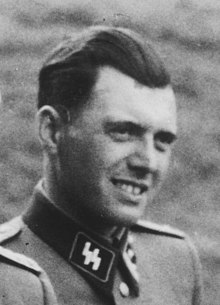 ヨーゼフ・メンゲレ |
Much debate is focused on Josef
Mengele, the infamous doctor of Auschwitz, commonly referred to as the
"Angel of Death". His most famous role was played out as the selector
on the platform at Auschwitz whose whims sent one either to the gas
chambers or to the camp. Mengele was the eldest son of a well-to-do Bavarian industrialist whose family still runs an implement factory in Germany. He is described by those who knew him in his youth as a serious student and a young person with obvious intelligence and ambition. In 1931 at the age of 20 he joined the Stahlhelm (Steel Helmet); he joined the SA in 1923 and upon being accepted into the Nazi party, he applied for membership in the SS. In his university studies, Mengele chose to concentrate on physical anthropology and genetics, eventually working under Otmar von Verschuer at the Frankfurt University Institute of Hereditary Biology and Racial Hygiene. Prior to his arrival at Auschwitz, he had published three articles, one of which was his dissertation in the Anthropological Institute at the University of Munich and which was entitled "Racial-Morphological Examination of the Anterior Portion of the Lower Jaw in Four Racial Groups". His medical dissertation, published in 1938, was entitled "Genealogical Studies in the Cases of Cleft Lip-Jaw-Palate". This was a predecessor to his work on genetic abnormalities and indirectly on twins which was to take place at Auschwitz. The third article - entitled "Hereditary Transmission of Fistulae Auris" was published in conjunction with research done on the Lenz-Vershuer principle of "irregular, dominant hereditary process". It appeared in 1928 that Mengele was destined for the academia. However, the route to a professorship was interrupted in 1938-1939 when he began his military experience by serving six months with a specially trained mountain light-infantry regiment. In 1940 he was placed in the reserve medical corps, following which he served three years with a Waffen SS unit. It was during this time period he was wounded and declared medically unfit for combat. Because he had acquitted himself brilliantly in the face of the enemy during the Eastern Campaign, he was promoted to the rank of captain. According to Dr. Hans Münch, a colleague of Mengele’s at Auschwitz, Mengele arrived at the camp in a somewhat privileged position - he had been wounded on the Eastern front and was the recipient of an array of medals, including the Iron Cross. It would also appear that Mengele selected Auschwitz because of the opportunities there to continue his research. According to one source (Lifton, The Nazi Doctors) he did receive financial support for his work there. Support for continuing his professional career in genetics appears in another book, And the Violins Stopped Playing written by Alexander Ramati, where it is reported that a Professor Epstein told a comrade that "he (Mengele) has offered to prolong my life. Mind you, not to save it, just to prolong it, if I prepare a scientific paper on noma, which he would publish under his own name. It will keep him away from the front, he said, and justify his presence here as a scientist." No doubt exists that Mengele was a very active commandant of the Auschwitz camp after he arrived there in 1943. Most doctors who have testified and prisoners who have testified have indicated he was ubiquitous, and, indeed, stories do exist of his selection activities and of his medical involvement. The Frankfurt Court which indicted him charged him with "hideous crimes" committed alone or with others "willfully and with bloodlust". Included in the crimes against humanity were selections, lethal injections, shootings, beatings and other forms of deliberate killing. He was religiously involved in all aspects, but particularly in the twins experiments, according to members of C.A.N.D.L.E.S., twins who survived the experiments. Descriptions of him indicate he was a very attractive man, always well groomed and very aristocratic in stature. Prisoners remember him as the man with the riding crop in his right hand and as the man who wore immaculately clean uniforms and boots with a high polish. Of all the aspects of Mengele’s character which are of interest, his research on twins is the focus of the C.A.N.D.L.E.S. organization. Beginning in 1944, twins were selected and placed in special barracks. Some of those selected - like Irene and Rene Guttman were already in the camp. Others like Eva and Miriam Mozes were selected on the ramp and placed in the twins barracks. It is believed that Mengele had worked with twins under Verschuer at the University of Frankfurt. Auschwitz offered Mengele unlimited number of specimens where twins could be studied at random. According to Dr. Miklos Nyiszli in Auschwitz: A Doctor's Eyewitness Account, twins provided the perfect experimental specimens. One could serve as a control while the other endured the experiments. It was well known in the camp that when a twin went to the infirmary, (s)he never returned and that the other twin disappeared too (Eva Mozes Kor, Echoes from Auschwitz). Nyiszli describes the shots of phenol which were used to kill the second twin. Twins in the experiments describe three days of what must have been psychological examination and three days of laboratory experiments. "Three times a week we were marched to Auschwitz to a big brick building, sort of like a big gymnasium. They would keep us there for about six or eight hours at a time - most of the days. ..... We would have to sit naked in the large room where we first entered, and people in white jackets would observe us and write down notes. They also would study every part of our bodies. They would photograph, measure our heads and arms and bodies, and compare the measurements of one twin to another. The process seemed to go on and on." (Echoes from Auschwitz, Kor). The laboratory experiments were described by Kor as follows: "Most of the time, they would take blood from one arm, and they gave us shots in the other." (Echoes from Auschwitz, Kor). Experiments did not end with the death of the twins. Dissection of the corpses for final medical analysis is well documented by Nyiszli and by Lifton. Being a twin, regardless of age, meant survival in 1944. Some 3,000 children (or about 1,500 sets of twins) were selected for the experiments. They were not terrified of him but rather they were often intimidated by some of what he did. They knew of his temper and his passion for his work. Yet, they were also aware of his role in their survival. "Being on Mengele’s list was better than being on no list," said Eva Mozes Kor. Of the children involved, only about 200 were alive when the camp was liberated by the Soviet Army on January 27, 1945. These are the children shown so often in documentaries walking between the wires of the Auschwitz I camp. Today they reside all over the world and they seek information on what was done to them. Their files have never been located and what was done to them remains a mystery today. To these twins, what happened to Mengele remains a mystery as well. While the bones found in 1985 have been identified by the authorities in charge of the investigation as Mengele’s, many do not believe that he is dead. Sources: C.A.N.D.L.E.S; Kor, Eva Mozes. Echoes from Auschwitz. IN.: C.A.N.D.L.E.S. 1995; Lifton, Robert Jay. The Nazi Doctors. The United States: Basic Books. 1986; Nyiszli., Dr. Miklos. Auschwitz: A Doctor's Eyewitness Account. New York: Fawcett Crest. 1960; Posner, Gerald L. and John Ware. Mengele: The Complete Story. New York: Dell Publishing. 1986; Ramati, Alexander. And the Violins Stopped Playing- from Josef Mengele. |
アウシュビッツの悪名高い医師で、一般に「死の天使」と呼ばれるヨーゼ
フ・メンゲレについて、多くの議論が交わされています。彼の最も有名な役割は、アウシュビッツのプラットホームで、気まぐれで人をガス室か収容所に送る選
択者として演じられた。 メンゲレはバイエルンの裕福な実業家の長男で、その一族は現在もドイツで器具工場を経営している。メンゲレを知る者は、若い頃の彼を、まじめな学生で、明 らかに知性と野心を持った若者であったと語っている。 1931年、20歳のときにシュタールヘルム(鋼鉄のヘルメット)に入隊した。1923年にSAに入隊し、ナチ党に受け入れられると、SSへの入隊も申請 している。 大学では身体人類学と遺伝学を専攻し、フランクフルト大学遺伝生物学・人種衛生学研究所のオトマール・フォン・ヴェルシュアーに師事しました。 アウシュビッツに到着する前に、彼は3つの論文を発表しており、そのうちの1つは、ミュンヘン大学人類学研究所での論文で、「4つの人種集団における下顎 前部の人種形態学的検査」というタイトルであった。1938年に発表された彼の医学論文は、「唇顎口蓋裂の症例における系譜学的研究」というタイトルで あった。これは、アウシュビッツで行われることになる遺伝子異常や間接的な双子に関する研究の前身となるものだった。第三の論文は、「瘻孔の遺伝的伝播」 と題され、「不規則で支配的な遺伝過程」というレンツ=ベルシュアーの原則に基づいて行われた研究とともに発表されたものである。1928年、メンゲレは 学問の世界に入る運命にあると思われた。 しかし、1938年から1939年にかけて、特殊訓練を受けた山岳軽装歩兵連隊で6ヵ月間の軍務に就くと、教授職への道は閉ざされた。1940年には予備 役医師団に配属され、その後ヴァッフェンSSの部隊で3年間兵役に就いた。その間に負傷し、医学的に戦闘不適格とされた。東方作戦で敵を前にして見事な働 きをしたため、大尉に昇格した。 アウシュビッツでメンゲレの同僚だったハンス・ミュンシュ博士によると、メンゲレは東部戦線で負傷し、鉄十字勲章をはじめ数々の勲章を授与され、やや特権 的な立場で収容所に到着したとのことだ。また、メンゲレがアウシュビッツを選んだのは、そこで研究を続ける機会があったからだと思われる。ある資料 (Lifton, The Nazi Doctors)によると、彼はそこでの研究に対して財政的な支援を受けていた。アレクサンダー・ラマティ著『そしてヴァイオリンは演奏をやめた』には、 エプスタイン教授が同志に「彼(メンゲレ)は私の命を長らえさせようと申し出た」と語ったことが書かれており、遺伝学で専門的キャリアを続けるための支援 があるようだ。もし、私がノマに関する科学的な論文を書いて、それを自分の名前で出版するならば、命を救うためではなく、ただ延命させるためにだ。そうす れば彼は前線から遠ざかり、科学者としてここにいることが正当化される、と。 メンゲレが1943年にアウシュビッツ収容所に到着した後、非常に活発な指揮官であったことは疑いようがありません。証言した医師や証言した囚人のほとん どが、彼はどこにでもいるような存在であったと述べており、実際、彼の選別活動や医療とのかかわりについての話も存在するのである。彼を起訴したフランク フルト裁判所は、「故意に、血の渇きをもって」単独または他者と行った「醜悪な犯罪」で彼を起訴しました。この人道に対する罪には、選別、致死注射、銃 殺、殴打、その他の意図的な殺戮が含まれます。彼はあらゆる面で宗教的に関与していたが、特に双子実験に関与していたと、実験を生き延びた双子の C.A.N.D.L.E.S.のメンバーたちは語っている。 彼は非常に魅力的な男性で、常に身だしなみを整え、非常に貴族的な背格好をしていたことが記述されている。囚人たちは、右手に乗馬鞭を持ち、完璧に清潔な 制服と光沢のあるブーツを身に着けた男として彼を記憶している。 メンゲレの人物像の中でも、双子の研究はC.A.N.D.L.E.S.という組織で注目されている。1944年から、双子が選ばれ、特別なバラックに入れ られた。選ばれた人の中には、イレーヌとレネ・グットマンのように、すでに収容所にいた人もいます。エヴァとミリアム・モゼスのように、傾斜路で選ばれて 双子用のバラックに入れられた者もいた。メンゲレはフランクフルト大学のベルシュアーの下で双子の研究をしていたと思われる。アウシュビッツはメンゲレ に、双子を無作為に研究できる標本の数を無制限に提供した。アウシュビッツのミクローシュ・ニジリ博士によれば、「アウシュビッツ。A Doctor's Eyewitness Account』によると、双子は完璧な実験標本になった。片方が実験に耐えている間、もう片方が対照となることができるのだ。双子の一人が医務室に行く と(中略)二度と戻ってこないこと、もう一人の双子も姿を消すことは、収容所ではよく知られていた(Eva Mozes Kor, Echoes from Auschwitz)。ナイシュリは、2番目の双子を殺すために使われたフェノールを注射したことを述べている。 実験に参加した双子は、3日間の心理学的検査と3日間の実験室での実験について述べています。「週に3回、私たちはアウシュビッツの大きなレンガ造りの建 物(大きな体育館のようなもの)に行進させられました。1回に6時間か8時間、ほとんどの日はそこに拘束されました......。最初に入った大きな部屋 では、私たちは裸で座らされ、白いジャケットを着た人たちが私たちを観察し、ノートに書き留めるのです。そして、私たちの体のあらゆる部分を観察するので す。写真に撮ったり、頭や腕や体のサイズを測ったり、双子のサイズを比べたり......。その作業は延々と続くようでした」。(アウシュビッツからの響 き』、コル)。 実験室での実験について、コルは次のように説明している。"ほとんどの場合、片方の腕から血を採られ、もう片方で注射を打たれました"(Echoes from Auschwitz, Kor) (Echoes from Auschwitz, Kor)。 実験は双子の死だけでは終わらなかった。最終的な医学的分析のための死体の解剖は、NyiszliとLiftonによってよく記録されている。 双子であることは、年齢に関係なく、1944年の生存を意味した。実験に選ばれたのは約3,000人の子供たち(約1,500組の双子)である。彼らは彼 を恐れていたわけではなく、むしろ彼のすることのいくつかに脅かされていたのだ。彼の気性も、仕事に対する情熱も知っていた。しかし、彼らは自分たちが生 き残るための彼の役割も知っていた。「メンゲレのリストに載ることは、リストに載らないことよりましだった」とエヴァ・モーゼス・コールは言った。 1945年1月27日、ソビエト軍によって収容所が解放された時、関係者のうち生きていたのは約200人だけだった。ドキュメンタリー番組で、アウシュ ビッツ第1収容所の電線の間を歩く姿がよく映し出される子供たちだ。今日、彼らは世界中に居住し、自分たちに何が行われたのかについての情報を求めてい る。しかし、彼らのファイルの所在は分からず、何が行われたのかは今も謎のままである。 この双子にとって、メンゲレに何が起こったかもまた謎のままである。1985年に発見された骨は、捜査当局によってメンゲレのものと確認されているが、彼 が死んだとは思っていない人も多い。 |
| Herta Oberheuser (1911 - 1978) |
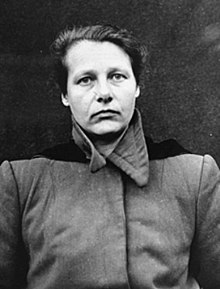 |
At Auschwitz extermination was
conducted on an industrial scale with several million persons
eventually killed through gassing, starvation, shooting, and burning. Dr. Herta Oberheuser killed children with oil and evipan injections, then removed their limbs and vital organs. The time from the injection to death was between three and five minutes, with the person being fully conscious until the last moment. She made some of the most gruesome and painful medical experiments during World War II, focused on deliberately inflicting wounds on the subjects. In order to simulate the combat wounds of German soldiers fighting in the war, Herta Oberheuser rubbed foreign objects, such as wood, rusty nails, slivers of glass, dirt or sawdust into the wounds. After World War II, in October 1946, the Nuremberg Medical Trial began, lasting until August of 1947. Twenty-tree German physicians and scientists were accused of performing vile and potentially lethal medical experiments on concentration camp inmates and other living human subjects between 1933 and 1945. Fifteen defendants were found guilty, and eight were acquitted. Of the 15, seven were given the death penalty and eight imprisoned. Herta Oberheuser was the only female defendant in the medical trial. She received a 20 year sentence but was released in April 1952 and became a family doctor at Stocksee in Germany. Her license to practice medicine was revoked in 1958. Sources: Hitler's Women - From Herta Oberheuser. |
アウシュビッツでは、ガス処理、飢餓、銃殺、焼却などの方法で、最終的
に数百万人の人々が産業規模で絶滅させられた。 ヘルタ・オーバーホイザー博士は、子供たちに油とエビパンを注射して殺し、手足と重要な臓器を摘出しました。注射をしてから死ぬまでの時間は3分から5 分、最後の瞬間まで意識ははっきりしていた。 彼女は第二次世界大戦中、被験者に意図的に傷を負わせることに重点を置き、最も陰惨で苦痛を伴う医学実験を行った。ヘルタ・オーバーホイザーは、戦争で 戦ったドイツ兵の戦闘時の傷を再現するために、木、錆びた釘、ガラスの破片、土、おがくずなどの異物を傷口に擦り込んだ。 第二次世界大戦後、1946年10月にニュルンベルク医学裁判が始まり、1947年8月まで続いた。23人のドイツ人医師と科学者が、1933年から 1945年の間に強制収容所の収容者やその他の生きた人間を対象にして、下劣で致命的な医学実験を行ったとして告発されたのだ。15人の被告が有罪とな り、8人が無罪となった。15人のうち、7人が死刑、8人が禁固刑に処されました。 ヘルタ・オーバーホイザーは、医学裁判の唯一の女性被告でした。彼女は20年の刑を受けたが、1952年4月に釈放され、ドイツのシュトックゼーで家庭医 になった。1958年に医師免許を剥奪された。 |
| Horst Schumann (1906 - 1983) |
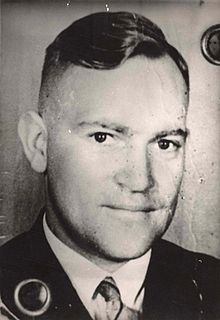 |
Dr. Horst Schumann (first
lieutenant of the air force and SS-Sturmbannführer), was born in 1906
as son of a physician in Halle/Saale. He entered the NSDAP in 1930 and,
two years later, joined the SA. In 1933, he was a doctor in Halle and
was employed in the Public Health Office. After the war began, Schumann
was recruited by the air force as a physician. Viktor Brack, director of the department "Aktion T 4" asked him to participate in the euthanasia program. Schumann agreed and, in January 1940, he became head of the euthanasia-institute Grafeneck in Wurttemberg, where people were killed by motor exhaust fumes. Half a year later, he became director of the institute Sonnenstein/Pirna in Saxonia. After Hitler officially ordered the extermination of “life unworthy of life,” Schumann belonged to a commission of doctors who transferred weak and sick prisoners in Auschwitz, Buchenwald, Dachau, Flossenbürg, Gross-Rosen, Mauthausen, Neuengamme and Niederhangen concentration camps to the euthanasia killing centers. On July 28, 1941, Schumann arrived in Auschwitz for the first time.Like Carl Clauberg, Schumann was searching for a convenient means of mass sterilization that would enable the Third Reich to carry out the biological destruction of conquered nations by “scientific methods” — through depriving people of their reproductive capacity. “X-ray sterilization” equipment was set up for Schumann in one of the barracks at Birkenau. Every so often, several dozen Jewish men and women prisoners were brought in. The sterilization experiments consisted of exposing the women's ovaries and the men's testes to X-rays. Schumann applied various intensities at various intervals in his search for the optimal dose of radiation. The exposure to radiation produced severe burns on the belly, groin, and buttocks areas of the subjects, and festering sores that were resistant to healing. Many subjects died from complications. The results of the X-ray sterilization experiments were unsatisfactory. In an article that he sent to Himmler in April 1944, titled “The Effect of X-Ray Radiation on the human Reproductive Glands,” Schumann expressed a preference for surgical castration, as being quicker and more certain. Schumann left Auschwitz in 1944. In October 1945, he suddenly appeared in Gladbeck where we was appointed urban sports-doctor. He opened his own consulting practice in 1949 with a refugee credit and was only recognized as a war criminal in 1951. Schumann fled and worked as a doctor on a ship before settling in the Sudan in 1955. Four years later, he fled again via Nigeria and Libya to Ghana. In 1966, Schumann was finally delivered to the German Federal Republic, where the trial against him was opened in September 1970. The proceedings were delayed in April 1971 because of Schumann's high blood-pressure. Without any public interest, Schumann was released from prison on July 29, 1972. He spent the rest of his life in Frankfurt and died on May 5, 1983, eleven years after he had been released. Sources: Institut fuer Sozial- und Wirtschaftsgeschichte - Uni Linz; The Auschwitz-Birkenau Museum - from Horst Schumann. |
ホ
ルスト・シューマン博士(空軍中尉、親衛隊上級幹部)は1906年、ハレ/ザールの医師の子として生まれた。1930年にNSDAPに入党し、その2年後
にSAに入隊した。1933年にはハレで医師となり、公衆衛生局に勤務していた。戦争が始まると、シューマンは空軍に医師として採用された。 アクシオンT4」の責任者であるヴィクトール・ブラックは、彼に安楽死プログラムに参加するよう要請した。シューマンはこれを承諾し、1940年1月、 ヴュルテンベルク州の安楽死研究所グラーフェネックの所長となり、自動車の排気ガスによって人々を殺すことになった。その半年後、彼はザクセン州のゾンネ ンシュタイン/ピルナ研究所の所長になった。 ヒトラーが「生きるに値しない生命」の抹殺を公式に命じた後、シューマンは、アウシュビッツ、ブッヘンヴァルト、ダッハウ、フローセンビュルク、グロス ローゼン、マウトハウゼン、ノイエンガンメ、ニーダーハングンの強制収容所で弱ったり病気になったりした囚人を安楽死の殺害センターへ移す医師団に所属し ていました。 1941年7月28日、シューマンは初めてアウシュビッツに到着した。カール・クラウベルクと同様に、シューマンは第三帝国が「科学的方法」によって征服 した国々の生物学的破壊を実行できるような、つまり人々の生殖能力を奪うことによって大量不妊手術を行う便利な方法を探していたのである。ビルケナウの兵 舎の一つに、シューマンのために「X線滅菌」装置が設置された。たびたび、数十人のユダヤ人男女の囚人が運び込まれた。殺菌実験は、女性の卵巣と男性の精 巣にX線を当てるというものである。シューマンは、さまざまな強さの放射線を、さまざまな間隔で照射し、最適な線量を探った。この実験では、腹、股、尻に ひどい火傷を負い、化膿してただれ、なかなか治らない。合併症で死亡する人も少なくない。X線による殺菌実験は、満足のいく結果が得られなかった。シュー マンは、1944年4月にヒムラーに送った論文「人間の生殖腺に対するX線放射線の影響」の中で、外科的去勢手術がより早く、より確実であるとして、その 希望を表明している。 シューマンは、1944年にアウシュビッツを離れた。1945年10月、突然グラッドベックに現れ、都市部のスポーツドクターに任命された。1949年、 彼は難民認定を受けて自分のコンサルタント事務所を開き、1951年に初めて戦犯として認定された。シューマンは、逃亡して船の上で医師として働き、 1955年にスーダンに定住した。4年後、ナイジェリア、リビアを経て、再びガーナに逃れた。1966年、ついにドイツ連邦共和国に引き渡されたシューマ ンは、1970年9月に裁判を開始された。1971年4月、シューマンの高血圧のため、裁判は延期された。1972年7月29日に釈放された。その後、フ ランクフルトで余生を過ごし、1983年5月5日、出所から11年後に死去した。 |
| Bruno Beger,
1911-2009 |
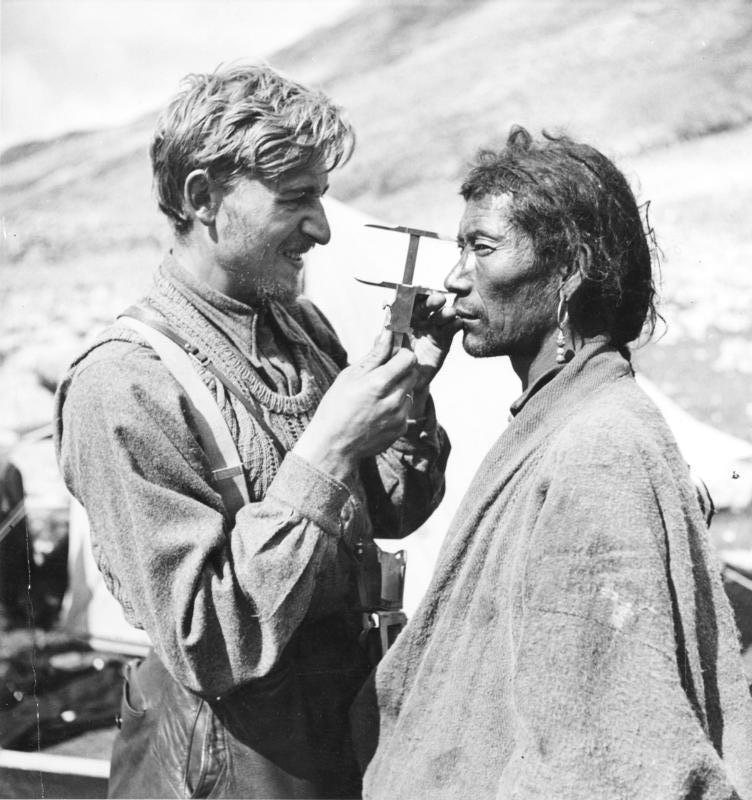 |
In 1934, Beger began working a
part-time job in the Race and Settlement Office of the SS where he
eventually became a section head. Beger was asked to be part of an
expedition to Hawaii, but while this was awaiting final approval, he
was invited on a trip to Tibet led by Ernst Schäfer which he accepted
instead. In a proposal he wrote to Schäfer, Beger stated his contribution to the expedition would be "to study the current racial-anthropological situation through measurements, trait research, photography and moulds... and to collect material about the proportion, origins, significance and development of the Nordic race in this region." All through the expedition, Beger kept a travel diary which was published in book form 60 years later, Mit der deutschen Tibetexpedition Ernst Schäfer 1938/39 nach Lhasa (Wiesbaden, 1998). Only 50 copies of it exist. Beger worked together with August Hirt at the Reichsuniversität Straßburg. His assignment, which he carried out, was to provide the Nazi doctor with detainees of diverse ethnic types from various concentration camps in order to serve Hirt's lethal racial experiments. The work involved selecting over 100 individuals from Auschwitz to be murdered for their skeletons and exhibited as the Jewish skeleton collection. They were mainly Jews, and the crime was exposed during the Nuremberg trials in 1946. The collection was sanctioned by Reichsführer-SS Heinrich Himmler, and designed by and under the direction of August Hirt, with Rudolf Brandt and Wolfram Sievers, general manager of the Ahnenerbe, being responsible for procuring and preparing the corpses. The victims were sent to Natzweiler concentration camp for gassing by SS-Hauptsturmführer Joseph Kramer, the Kommandant of the camp. Their corpses were then sent to Hirt in Strasburg. In these endeavours he was assisted by doctors Hans Endres, Hans Fleischhacker, Heinrich Rübel and Rudolf Trojan. In February 1948, Beger was classified as "exonerated" by a denazification tribunal unaware of his role in the skeleton collection. In 1960, an investigation into the collection began in Ludwigsburg, and Beger was taken into custody on 30 March 1960. He was released four months later. The investigation continued until coming to trial on 27 October 1970. Beger claimed that he was unaware the Auschwitz prisoners he measured were to be killed. While two others indicted in the trial were released, Beger was convicted on 6 April 1971, and sentenced to three years in prison for being an accomplice in the murder of 86 Jews. Upon appeal his sentence was reduced to three years of probation. Neither of his colleagues with whom he was tried, Hans Fleischhacker and Wolf-Dietrich Wolff, were convicted.According to his family, Beger died in Königstein im Taunus on 12 October 2009. |
1934年、ブルーノ・ベガーはSSの人種・入植局でパートタイムの仕
事を始め、やがて課長となった。ベガーは、ハワイ遠征の依頼を受けたが、最終的な承認を待っている間に、エルンスト・シェーファー(Ernst Schäfer,
1910-1992)が率いるチベットの旅に招かれ、これを引き受けた。 ベガーは、シェーファーに宛てた企画書の中で、「測定、形質調査、写真撮影、型取りなどを通じて、現在の人種・人類学の状況を研究し、この地域における北 欧人種の割合、起源、意義、発展に関する資料を収集すること」をこの探検への貢献として述べている。 ベガーは探検の間中、旅日記を書き続け、60年後に"Mit der deutschen Tibetexpedition Ernst Schäfer 1938/39 nach Lhasa (Wiesbaden, 1998)"として出版された。現存するのは50部のみである。 ベガーはアウグスト・ヒルトとともに帝国大学シュトラスブルク校に勤務していた。彼の任務は、ヒルトの被験者の死を伴う人種実験のために、様々な強制収容 所から多様な民族の収容者をナチスの医師に提供することだった。この仕事では、アウシュビッツから100人以上の人間を選んで殺害し、その骨格をユダヤ人 骨格コレクションとして展示することであった。彼らは主にユダヤ人であり、その犯罪は1946年のニュルンベルク裁判で暴露された。このコレクションは、 ハインリッヒ・ヒムラー親衛隊大将の認可を受け、アウグスト・ヒルトの指揮のもとに設計され、ルドルフ・ブラントとアーネンエアベ総 支配人のウォルフラム・シーヴァースが死体の調達と準備を担当した。犠牲者はナッツヴァイラー強制収容所に送られ、収容所長のヨーゼフ・クラマー親衛隊上 級大将によってガス処刑されました。その死体は、シュトラスブルクのヒルトの元に送られた。この作業には、医師のハンス・エンドレス、ハンス・フライシュ ハッカー、ハインリッヒ・リューベル、ルドルフ・トロイヤンらが協力した。 1948年2月、ベガーは、骨格収集の役割を知らないまま、ナチス戦争犯罪裁判によって「無罪」に分類された。1960年、ルートヴィヒスブルクでコレク ションに関する調査が始まり、ベガーは1960年3月30日に拘束された。ベガーは1960年3月30日に拘束されたが、4ヵ月後に釈放された。その後、 1970年10月27日に裁判にかけられるまで、捜査は続けられた。ベガーは、自分が測定したアウシュビッツの囚人が殺されるとは知らなかったと主張して いる。この裁判で起訴された他の2人は釈放されましたが、ベガーは1971年4月6日に有罪判決を受け、86人のユダヤ人殺害の共犯者として3年の刑を宣 告されました。控訴審では、3年の保護観察処分に減刑された。ベガーの家族によると、ベガーは2009年10月12日にケーニヒシュタイン・イム・タウヌ スで死去した。 |
| Rudolf Hermann
Brandt, Rudolf Brandt, 1909-1948. |
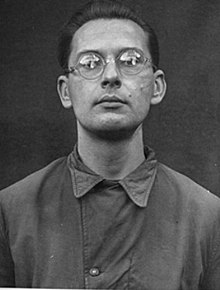 |
Rudolf Hermann Brandt (2 June
1909 – 2 June 1948) was a German SS officer from 1933–45 and a civil
servant. A lawyer by profession, Brandt was the Personal Administrative
Officer to Reichsführer-SS (Persönlicher Referent vom Reichsführer SS)
Heinrich Himmler and a defendant at the Doctors' Trial at Nuremberg for
his part in securing the 86 victims of the Jewish skeleton collection,
an attempt to create an anthropological display of plaster body casts
and skeletal remains of Jews. He was convicted of war crimes and crimes
against humanity, and executed in 1948. Felix Kersten, a Finnish doctor
who reportedly saved thousands of Jews by influencing Himmler during
the massage therapy he gave him throughout the war, tried to save
Brandt from execution, as Brandt helped him by adding names on the
lists intended to save camp prisoners. Rudolf Brandt, the son of a railway worker, was born on 2 June 1909, and raised in modest circumstances in the town of Frankfurt an der Oder. Brandt was a member of the student's stenography (shorthand) club at the Realgymnasium, and in 1927, at the age of 18, won a competition with a transcription speed of 360 syllables per minute. He attended the University of Berlin and the University of Jena (1928–1932), simultaneously working from 1928 to 1930 as a court reporter at the Provisional National Economic Council. Brandt would continue to practice stenography in the evenings with his colleague and former Frankfurt schoolmate Gerhard Herrgesell. Brandt was awarded a doctorate of law from the University of Jena in July 1933. He joined the Nazi Party in January 1932[1] (membership number 1,331,536) and the SS in October 1933 (membership number 129,771). Brandt and his skills in transcription were noticed by Heinrich Himmler, who had him transferred to his staff. On 11 December 1933, he joined the Staff of Reichsführer-SS Himmler in the capacity of clerk. In November 1935, he was commissioned an Untersturmführer (second lieutenant) and ultimately rose to the rank of Standartenführer (colonel). In 1936, Brandt was named Chief of the Personal Staff of the Reichsführer-SS (Leiter des Persönlichen Stabes RFSS), and in 1937, Persönlicher Referent des RFSS, a position he held until the end of the war in May 1945. In this position Brandt handled Himmler's entire correspondence with the exception of matters pertaining to the Waffen-SS or the Police. "Because of his ability as a perfect stenographer, his punctuality, his untiring diligence, he became Himmler's convenient and omnipresent registering, reminding and writing machine, complaining about being overworked, and on the other hand, declaring with pride that he had to produce 3000 – 4000 outgoing letters per year. Brandt would begin work at seven in the morning, no matter what time he had gone to bed the night before. Three or four hours of sleep were sufficient for him. As soon as Himmler had risen in the morning and washed, Brandt would go to him loaded with papers and files, and while Himmler shaved he would read him the most important items of the morning's mail...If there was bad news, Brandt would preface it by saying, "Pardon, Herr Reichsführer," and thus forewarned, Himmler would temporarily suspend his shaving operations: a precautionary measure to prevent cutting himself. Brandt was certainly most important. He was the eyes and ears of his master and the manner in which he presented a matter to Himmler was often of decisive importance." |
Rudolf Hermann Brandt, 1909年6月2日
-
1948年6月2日)は、1933年から45年までドイツの親衛隊員、公務員であった。ユダヤ人の石膏模型と人骨を人類学的に展示しようとしたユダヤ人人
骨コレクションの86人の犠牲者を確保したことでニュルンベルク医師裁判の被告となった。戦争犯罪と人道に対する罪で有罪判決を受け、1948年に処刑さ
れた。フィンランドの医師フェリックス・ケルステンは、戦争中ヒムラーにマッサージ療法を施し、影響を与えることで数千人のユダヤ人を救ったと言われてい
るが、ブラントが収容所の囚人を救うためのリストに名前を追加して彼を助けたため、ブラントを処刑から救おうとした。 ルドルフ・ブラントは、1909年6月2日に鉄道員の子として生まれ、フランクフルト・アン・デア・オーデルの町で質素に育った。1927年、18歳のと き、1分間に360音節を書き写す速さでコンクールに優勝した。ベルリン大学、イエナ大学(1928-1932)に通い、同時に1928年から1930年 まで臨時国民経済会議の法廷速記官として勤務した。ブラントは、同僚でフランクフルトの学友だったゲルハルト・ヘルゲゼルと夜な夜な速記術の練習を続ける ことになる。 ブラントは1933年7月にイエナ大学から法学博士号を授与された。彼は1932年1月にナチ党に入党し[1](会員番号1,331,536)、1933 年10月に親衛隊に入隊した(会員番号129,771)。ブラントとその転写の技能はハインリッヒ・ヒムラーに注目され、彼のスタッフに編入させられた。 1933年12月11日、事務官としてヒムラー親衛隊大将の幕僚に加わる。1935年11月、少尉に任命され、最終的には大佐に昇進した。 1936年、ブラントは親衛隊個人参謀長(Leiter des Persönlichen Stabes RFSS)、1937年には親衛隊参謀長(Persönlicher Referent des RFSS)となり、1945年5月の終戦までその職を続けた。この役職でブラントは、ヴァッフェンSSや警察に関する事項を除いて、ヒムラーのすべての書 簡を扱った。 ヒムラー直属のアウスラントSD部長、ワルター・シェレンベルクはブラントについてこう語っている。 「完璧な速記者としての能力、時間厳守、たゆまぬ勤勉さから、彼はヒムラーの便利で遍在する登録、念押し、筆記マシーンとなり、過労を訴える一方で、年間 3000〜4000通の往信を作成しなければならないと誇らしげに宣言していた。ブラントは、前夜何時に寝ても、朝7時には仕事を始めた。3、4時間の睡 眠で十分だった。ブラントはヒムラーが朝起きて洗濯をするとすぐに、書類やファイルを抱えて彼のところに行き、ヒムラーが髭を剃っている間にその朝の郵便 物の中から最も重要なものを読み上げる。悪い知らせがあれば、ブラントは「失礼しました、帝国総統」と前置きして、こう警告するとヒムラーは一時的に髭剃 りを中止した。ブラントは確かに最も重要な存在だった。彼は主人の目と耳であり、彼がヒムラーにどのように問題を提示するかは、しばしば決定的な重要性を 持っていた」 |
++
リンク(アウシュビッツ医学関係)
リンク(生命倫理や医療情報に関するもの)
文献
その他の情報
Copyleft,
CC, Mitzub'ixi Quq Chi'j, 1996-2099